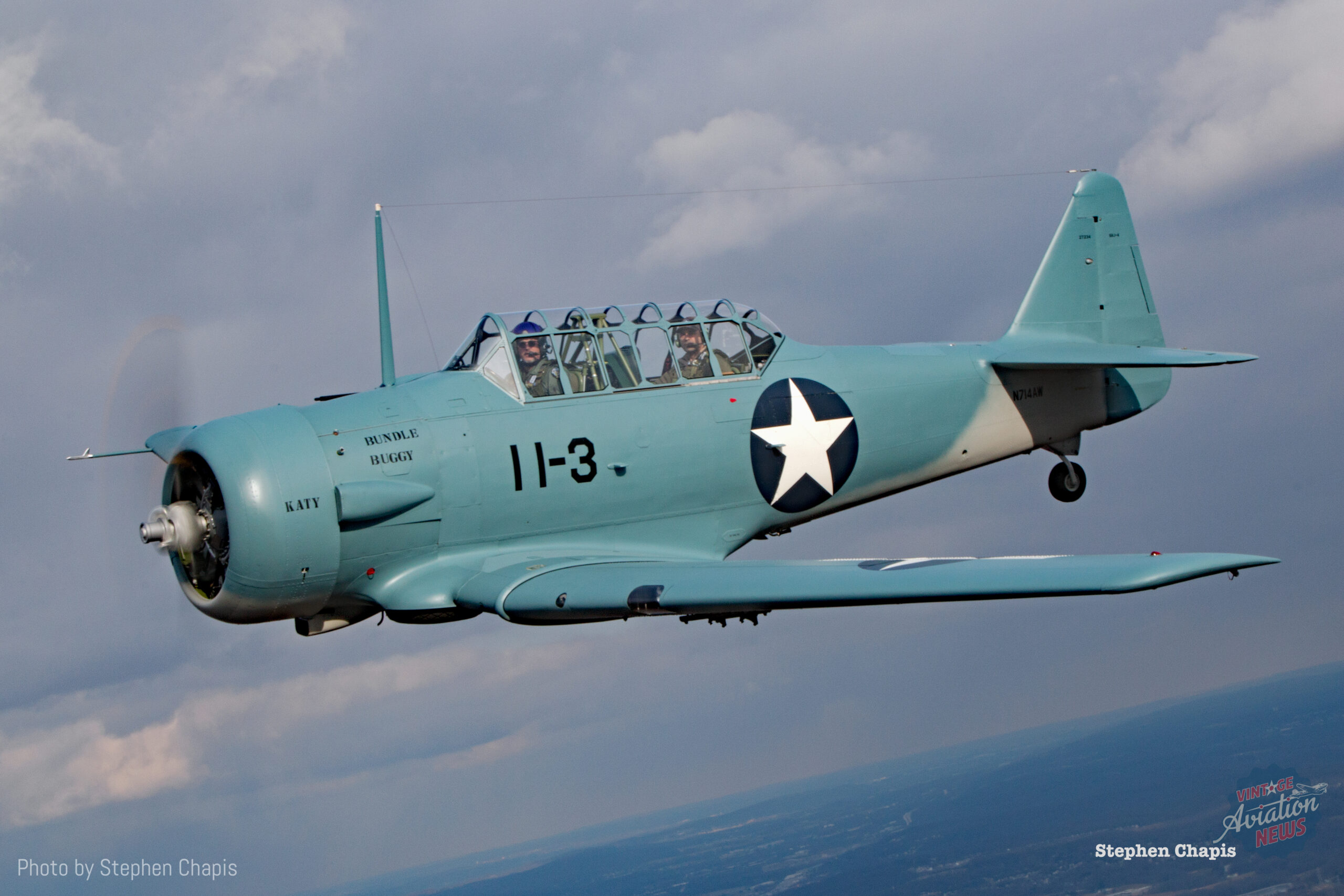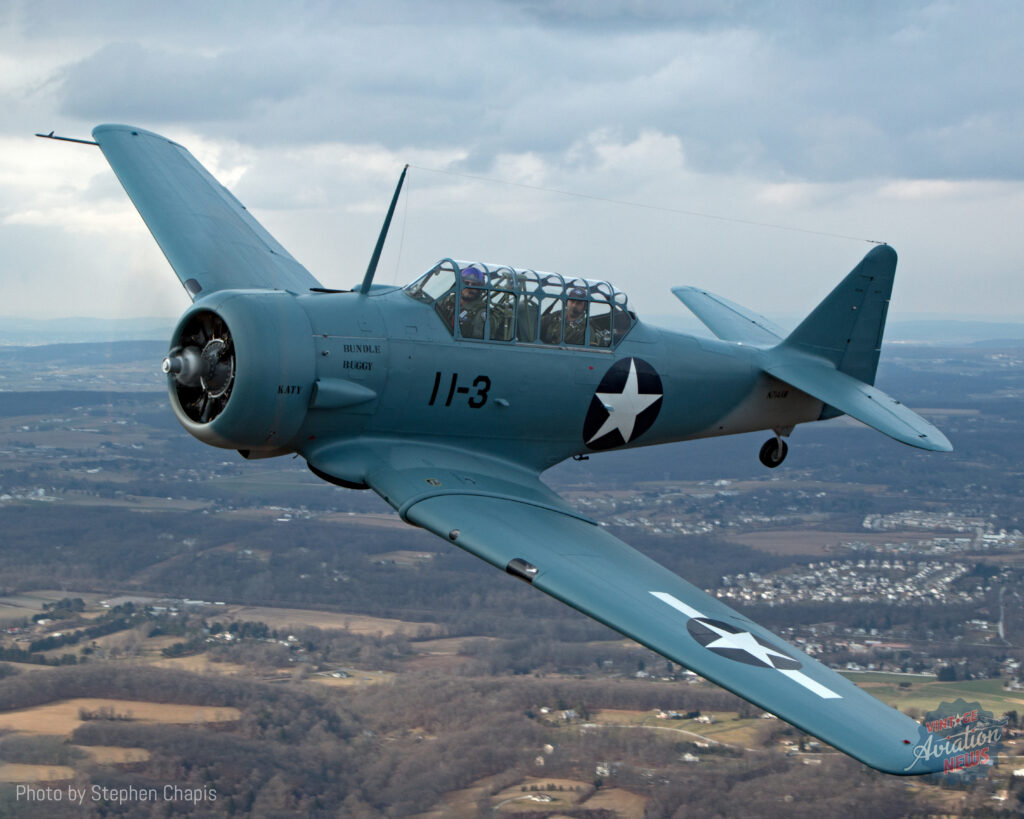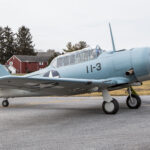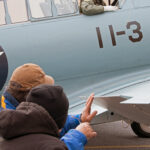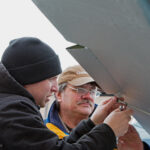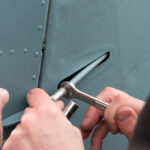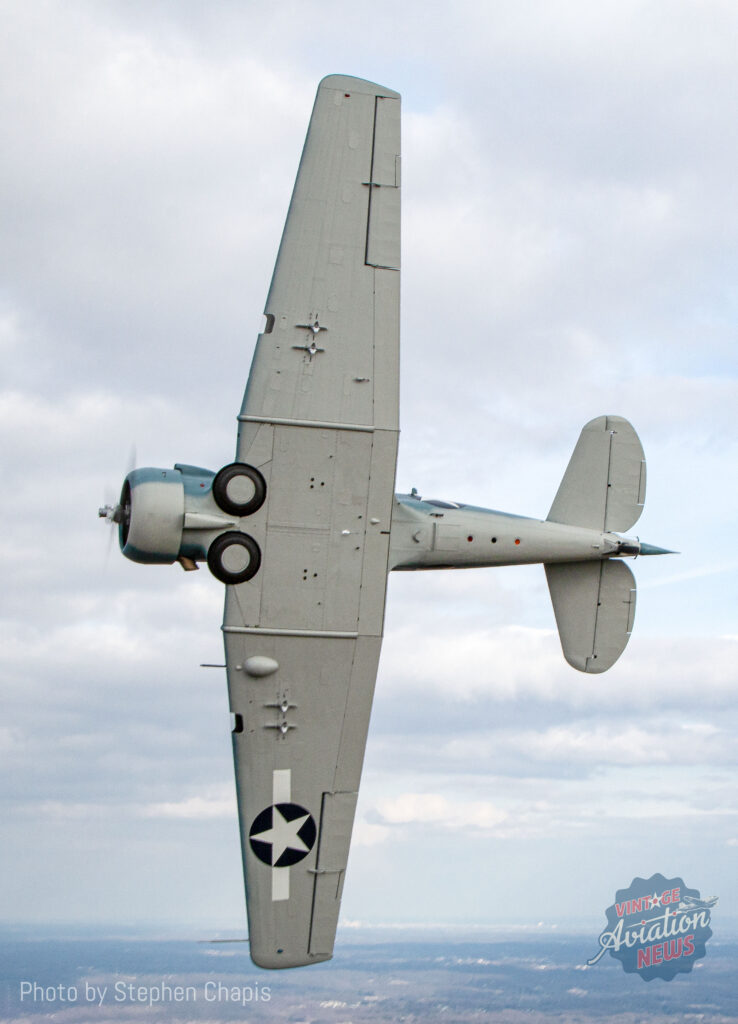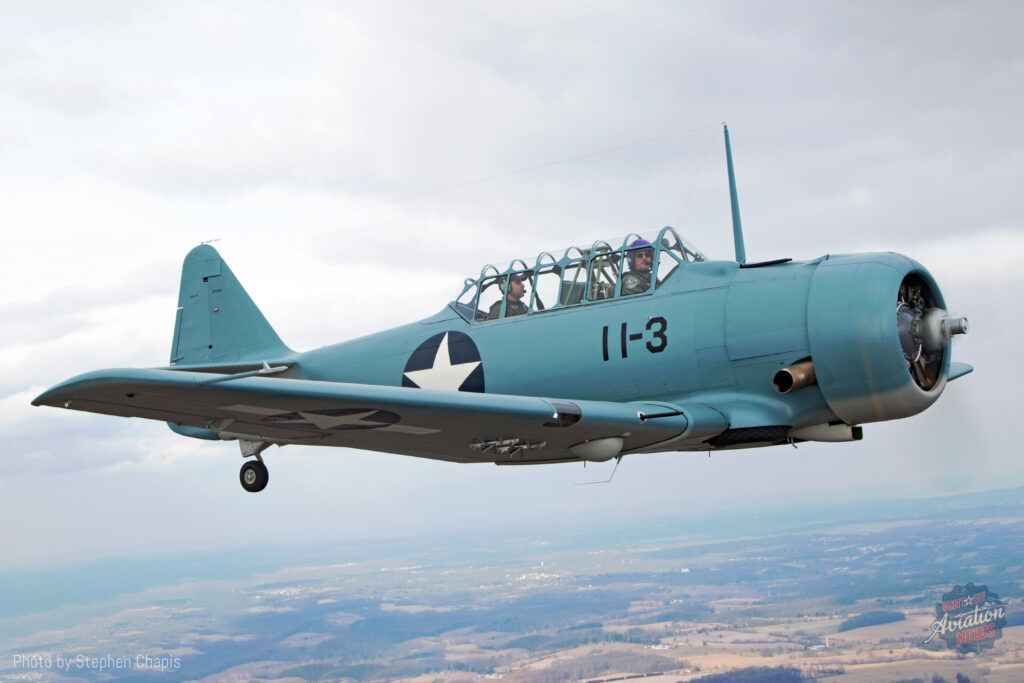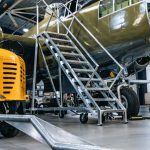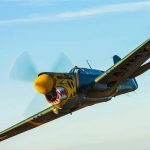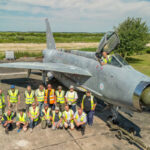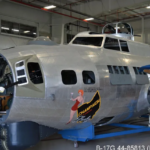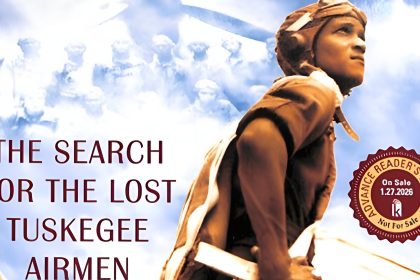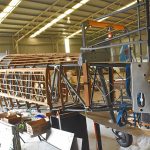In January 2017, when Mark and the late-Joe Denest and their team at the Smoketown, Pennsylvania-based MD Aero Restorations completed the restoration of Fagen Fighters’ 1943 SNJ-4 in January 2017, Stephen Chapis was there to document the early test flights and get first-hand accounts of those flights from John Glen Fuentes and Ed Shipley.
By Stephen Chapis
John Glen Fuentes works for a major airline as a 767 Line Check Airman that will soon transition to the 787 and also flies warbirds at the Military Aviation Museum in Virginia Beach, Virginia, and the Capital Wing of the CAF in Culpeper, Virginia. In addition to several hundred hours in BT-13s and SNJs, John is rated in the FG-1D, Hurricane, FM-2, TBM, Me-108 and will soon check out in the Mosquito.
In a January 2017 interview, John related how he got into warbird flight-testing. “I’ve got about 450 hours in SNJs and T-6s plus a lot of time in the BT-13. I was introduced to Fagen when I test-flew his BT-13, which was another example of a pristine restoration by MD Aero. As an A&P and IA was able to talk technical with Mark and his team during my numerous visits to the shop. So Mark and I got to know each other that way and after I did some instructing with him in that airplane we ferried it out to Minnesota. It was a great trip.” At Oshkosh 2010 the Fagen BT-13 won Best BT-13 and Phoenix Award, while Mark and his father took home the Silver Wrench.
As the SNJ approached completion near the end of 2016, John and Mark planned to do the same thing, but weather and John’s airline schedule continually threw a wrench into their plans, so they decided that John would do the initial test flight and Ed Shipley would perform the follow on test flights. John explained the extensive preparation and planning that went into the first post-restoration flight of SNJ-4 BuNo 27234, which took place on January 13, 2017 at Smoketown Airport (S37) where MD Aero is based, “First we pulled panels and really looked over the airplane. We looked down the “hell hole” at all the cables and turnbuckles to make sure they are going over the pulleys the way they are supposed to. Then Mark and his guys (Karl Skotleski and Luke Jones) pulled the side panels off and looked all through there.
Once I looked over the paperwork, we pulled the airplane outside and did an engine run with the side panels off the accessory section to make sure there were no leaks or anything. Then we buttoned it up and ran through a full systems check where we checked everything that can be checked on the ground- flaps, trim controls, flight controls, and a full engine run-up, magneto check, prop cycle, and carb heat. Once we shut it down, we did another leak check and buttoned it all backup.
Then it was time for a taxi check, which is basically taxiing to the end of the runway checking the brakes, and making sure the tailwheel is steering correctly. All that went well, so after another run-up I took it out onto the runway, set the brakes, and brought it up to takeoff power. Everything looked good, so I released the brakes and basically did a high-speed taxi run to about 60-70mph and then throttled back. With that, I was checking acceleration, controllability, and braking as well as making sure the engine was making power and the prop was giving me the rpm I need. That all went well, so I taxied back to the end and got ready to fly.”
On that day John performed two flights, the first of which was relatively uneventful other than the fact that John discovered the elevator trim was rigged backward, to which John said, “When I cycle the trim on the ground I am checking for a full range of motion and all that, but we should have done the thought process of looking at the trim tab to make sure it was going in the right direction. It wasn’t a big deal and it was fixed rather easily.”
The runway (10/28) at Smoketown is 2,750 x 50ft and the western threshold is 33 feet higher than the east threshold. John and the SNJ are more than capable of operating from that runway, but after his initial air work over S37 on the first flight, which was done with the gear down, John went to Chester County Airport (MQS) 16nm to the east where the 5,400 x 100ft runway (11/29) offered a better margin of safety in case of an emergency. After an uneventful touch-and-go at MQS, John headed back to Smoketown. He takes the story, “All during the flight you want to keep an eye on temperatures and pressures to make sure everything is in the green. When I got back over to Smoketown I went through a series of banks at varying degrees and did a couple stalls. An SNJ will generally break to the right and that is what this one did.”
Once back on the ground they fixed the elevator trim and looked over the entire aircraft. Happy with what they saw John and Mark decided to make a second flight. As John explained it involved more maneuvers and system checks, “I took it back up over the airport and cycled the gear and flaps and some slow flight. Then I did a full stall series- accelerated, clean, dirty, etc. On that flight, I was watching the engine instruments closely because I was running the engine a little bit harder. Again after the air work over Smoketown, I went over to Chester County again for a series of landings at various flap settings and a few touch & gos.” Due to the fact that Fagen’s SNJ has all the components and systems that it would have had installed during World War II it is much heavier than the average Texan. John found this out on his last landing at S37, “Yeah, the airplane is waaaay heavier than other SNJs! When I got into the flare at Smoketown I just pulled the power because I’ve got a short runway and I wanted to get it on the ground. When I did that it just basically quit flying and bounced and I thought, ‘Wow, this thing is heavy.’” John’s job was done and now it was up to Ed Shipley to complete the flight-testing.
For most warbird enthusiasts, Ed Shipley needs no introduction, but in case you’ve been living off the grid for the last few decades we’ll give you a short synopsis. Shipley once flew 747s for Atlas Air. Off the coast of Hawaii in 1995, he was one of a number of warbird pilots that flew warbirds off the deck of USS Carl Vinson (CVN-70) to commemorate the 50th anniversary of the end of World War II. Ed’s airshow career began with the “Six of Diamonds” formation aerobatic team and later became a founding member of “The Four Horsemen”, an aerobatic team of four P-51s flown by Ed, Jim Beasley, Jr., Dan Cardarale, and the late-Vlado Lenoch. Later iterations of the team included Ed, Steve Hinton, and Dan Friedkin flying Bearcats, Corsairs, Lightnings, Spitfires, and Sabres.
It was a bitterly cold and overcast day on January 29, 2017, when I met up with Ed, Mark, Joe, and MD Aero mechanics Luke Jones and Karl Skotleski at Smoketown Airport. Throughout the morning and early afternoon, Ed made half-dozen flights in the SNJ that centered on trimming the aircraft in all three axes. He would go up for 10-20 minutes and upon landing he would tell Mark what the airplane was doing at which point Karl and Luke would make the required adjustments to slowly dial in the aircraft. With wind chills in the upper teens, the aircraft was pushed into the hangar when the work took longer than 10 or 15 minutes. Mark’s team took the opportunity to inspect the accessory section of the engine for leaks. None were seen, so the flying continued. When Ed was satisfied with the handling of the aircraft we headed over Chester County for lunch and to meet up with our photo pilot Buzz Cortese who kindly offered the use of his SNJ-4.
During lunch I talked to Ed about warbird flight-testing, “Well it takes faith and balls, but Mark knows how to build airplanes so that right there takes a lot of worry out of the equation. All we are trying to do is address the nic-noids that make this airplane as special as it is. This is a ground up restoration and it is the only SNJ that I have seen that has every little thing an SNJ had in it during the war and it all works. So the only things I was concerned about today, was does it make power? Can it pull power? Can the prop go all the way up, so you have full thrust on takeoff? Is fuel flowing around? Is the electricity swinging around in circles? And do the hydraulics work?
John, Mark, and his guys had already sorted out that stuff, so really what we are doing now is getting it up in the air and seeing how it flies. So we’ve put about an hour, actually, about two hours, on it already and the only thing that has come up is that it needs to be trimmed. Right now we’ve got to work on getting the wings level because right now it is right wing heavy, and getting the rudder trim right. It is also nose heavy. I could tell it was nose heavy when I was running it up because I felt it squat down and lean forward. It is not a safety of flight issue, it is just you need to have it right. You should just need to trim it up. If it’s perfect, you should be able to put all the trim controls to neutral, the plane should fly straight and level and this one is not quite doing that yet. It’s not because anything was done wrong, it is just a matter of dialing it in.
When I get up in the air I am looking at all the obvious things, they have already swung the gear a number of times, so the gear is working okay. Then every time I come down we pull panels, and they look at all the stuff. Is the engine leaking? Is the prop throwing anything? Are there any hydraulic leaks and stuff like that? They check that every single time, so you gain confidence with it every time you go up.”
As we headed out for our photo sortie Ed summed up the testing of Fagen’s SNJ, “Ya know these airplanes are not like when they came off the assembly line 70 years ago. They are better, but each one is different, they each have their own little nuances and characteristics. So far it is going really well, but you have to be pragmatic about it and not get overly excited about the process. You can’t hope something is going to work, it really has to work.”
The weather was less than optimal for a photo sortie, but it was then or never because the following day, Ed and Mark would deliver the SNJ to its new home at Fagen Fighters WWII Museum in Granite Falls, Minnesota. Flying north from Pennsylvania to Minnesota in the dead of winter in an unheated, un-insulated SNJ is not for the faint of heart but Ed and Mark made the trip without any trouble.
Six months after this stellar example of a North American SNJ-4 was completed and took to the cold gray skies over Smoketown Airport, Pennsylvania it basked in the warm summer sun at Wittman Regional Airport, Wisconsin waiting to be judged at Oshkosh AirVenture 2017. Just like previous MD Aero Restorations projects, SNJ-4 BuNo 27234 took home its share of awards. The combat-ready SNJ took home the Phoenix Award and Most Authentic Restoration, while MD Aero was awarded a Gold Wrench. This once again proves that it is not the warbirds themselves that are special, it’s the mechanics and fabricators in the restoration shops that obsess over minute details to produce an aircraft that looks better than it did when it left the factory seven decades ago and to the pilots that use their experience and skills to ensure it flies better than ever so that it will continue to honor the legacy of the Greatest Generation.







